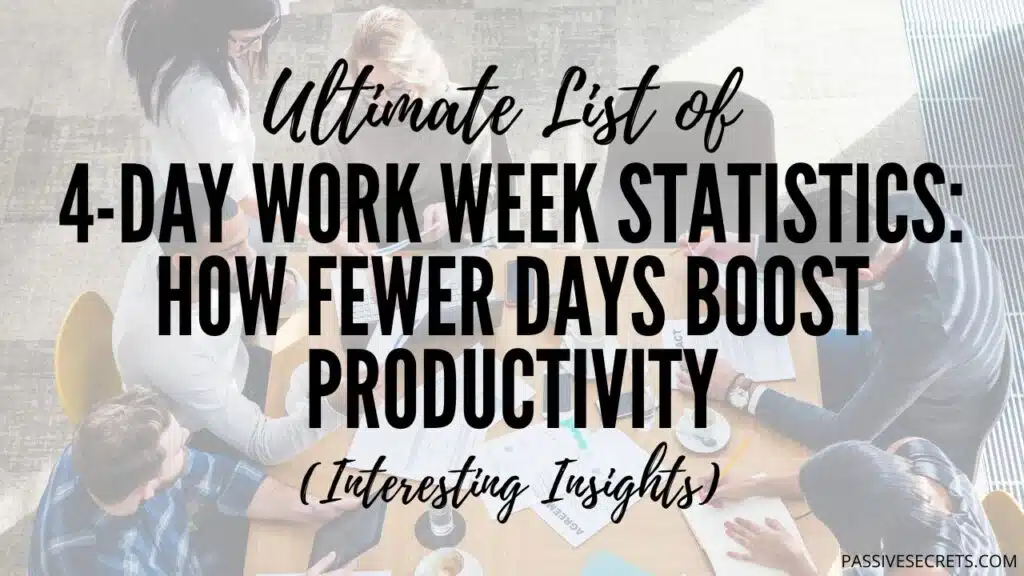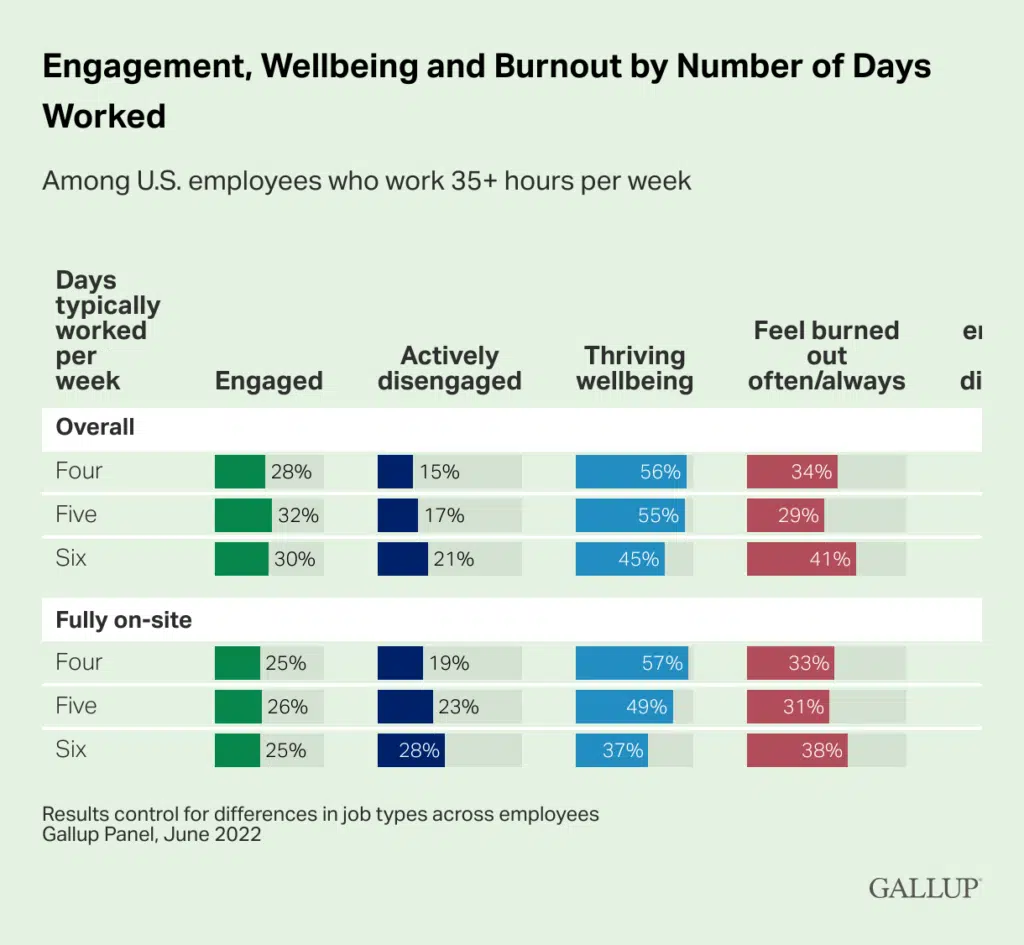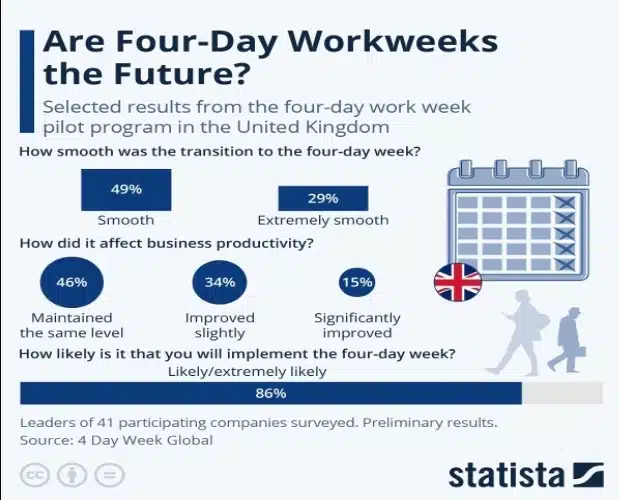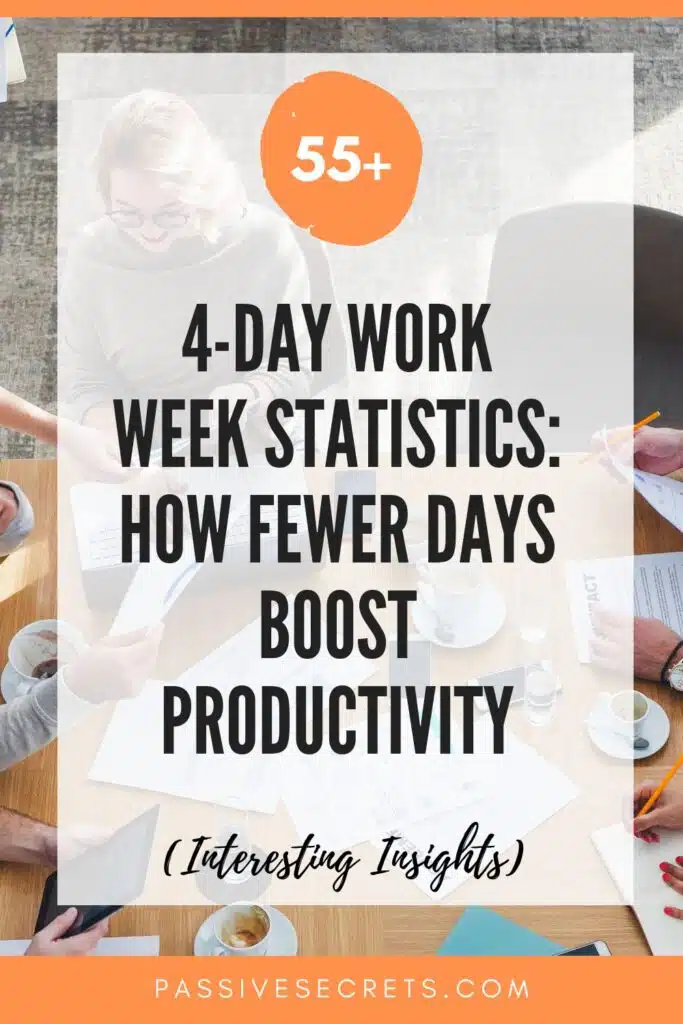
Could working fewer days lead to greater productivity and employee satisfaction? The concept of a 4-day work week is no longer just a workplace experiment—it’s a movement reshaping how we think about work-life balance.
With businesses reporting up to a 40% increase in productivity and employees experiencing significantly reduced stress levels, the statistics surrounding this innovative work model are nothing short of compelling.
From its impact on profitability to the ways it boosts employee engagement, the numbers tell a powerful story.
In this article, we’ll explore the latest 4-day workweek statistics, uncovering trends, benefits, and challenges that every forward-thinking organization should consider.
Key 4-day Work Week Statistics & Facts (Editor’s Pick)
- The average working week for US employees is at 34.3 hours.
- 81% of full-time workers prefer a 4-day workweek. Out of this 81%, a majority (89%) of them are more than willing to make sacrifices to get it.
- 44% of on-site employees would change their jobs to enjoy a 4-day workweek.
- 54% of Irish and German workers prefer a shorter workweek than a longer salary.
- 63% of digital leaders with a 4-day workweek and 74% with a 3-day workweek reported their policies were highly successful.
- 81% of young people think a 4-day workweek would increase productivity.
- 80% of workers are enthusiastic about a 4-day workweek.
- About 66% of businesses using a 4-day workweek say they have reduced costs.
- 49% of surveyed businesses in the U.K. say the transition to a 4-day workweek was smooth.
What Does a 4-day Work Week Mean?
A four-day work week is a schedule in which employees work four days instead of the traditional five while maintaining a standard total number of weekly work hours.
This can lead to longer daily work hours but allows for an extra day off each week.
Employees will focus on completing their tasks within four days instead of 5, so they can have three days off. This will not affect their pay either.
General 4-day Work Week Statistics
1. The average working week for all employees on private nonfarm payrolls in the United States was 34.3 hours in October 2024. (source)
2. In Q3 2024, UK full-time workers averaged 36.9 hours/week, a significant drop from 2020 when the COVID-19 pandemic impacted work hours. (source)
3. In Q3 2024, 59.3% of UK employees worked 31-45 hours/week, while 14.3% worked more than 45 hours/week. (source)
4. In Q2 2024, full-time workers in London averaged 37 hours/week, a slight decrease from 37.2 hours/week in Q2 2023. (source)
5. In 2022, Colombian workers averaged 2,400 hours (46.3 hours/week), the most in the OECD, while German workers averaged 1,340 hours (25.8 hours/week), the least. (source)
6. 21% of workers are willing to take a pay cut for a 4-day workweek, with most (51%) accepting a 5% or less pay reduction. Others would consider a 10% (23%), 15% (7%), or 20% or more (19%) pay cut. Meanwhile, 79% of workers are not willing to take a pay cut. (source)
7. 81% of full-time workers prefer a 4-day workweek. Out of this 81%, a majority (89%) of them are more than willing to make sacrifices to get it. For example, 54% say they are ready to work longer hours. (source)
8. 67% of workers say they want a 4-day workweek, 10 hours per day. (source)
9. 92% of companies involved in a 4-day workweek experiment say they plan on continuing the method. The experiment showed that a shorter workweek boosted productivity, team culture, and morale. (source)
10. 93% of U.S. managers would like their team to have a 4-day workweek. Additionally, 64% of them expect their organization to adopt the 4-day workweek mode within the next few years. (source)
11. Additionally, 66% of workers agree that working only four days would improve their mental well-being. (source)
12. 66% of workers say they prefer to spend their fifth day (Friday) with friends. 67% prefer to spend time with their families. (source)
13. According to Gallup research, only 8% of over 12,313 surveyed employees say they work four days weekly. Also, 84% had the traditional five-day workweek, while 8% worked six days weekly. However, the 6-day workweek employees experienced very high rates of burnout. (source)
14. 4-day workweek workers have less work engagement rates compared to 5 and 6-day workweek. (source)

15. Up to 44% of on-site employees would change their jobs to enjoy a 4-day workweek. (source)
16. 15% of the surveyed employees admitted that no amount of money would make them go back to working five days a week. (source)
17. 40% of companies in a survey have either implemented a 4-day workweek or have begun to do so. (source)
18. In Poland, 28% of surveyed workers prefer a 4-day workweek. (source)
19. Over 32% of employees in the U.S. between 58 and 76 years prefer a 4-day workweek. This percentage makes them the age group with the highest desire to want a 4-day workweek. However, the age group with the lowest desire is those between 18 and 25 years old. (source)
20. In the UK, the average work hours per week is 36.9 hours. (source)
21. In a survey, 54% of Irish and German workers prefer a shorter workweek than a longer salary. (source)
22. According to 96.5% of employees in Germany who want a 4-day workweek, the primary reason for wanting that is because they want more time for themselves. However, a smaller number (31%) of employees say they want a shorter workweek due to health issues. (source)
23. In Hungary, one-fourth (25%) of employees admitted that “the introduction of a 4-day workweek was a dream”. Another 25% say they are willing to change jobs to enjoy a 4-day workweek. (source)
24. Over 64% of businesses in the U.K. support the introduction of a 4-day workweek. Only 28% opposed it, preferring the traditional five or six-day workweek. (source)
25. Also, the same recent survey showed that larger businesses favored having a 4-day workweek, with 76% selecting the notion. Microbusinesses were also in support but with only 53%. (source)
26. According to a Gartner poll, 63% of surveyed employees say part of their top innovative benefit that would attract them to a job is having a 4-day workweek with the same pay. (source)
27. Top companies offer a 4-day workweek (source).
Some of the top companies that have a 4-day workweek policy include:
28. Over 45% of workers in a survey who left their jobs did so due to inflexible work hours. Also, the same survey showed that 39% of workers left their jobs because they worked too many hours. (source)
29. 40% of surveyed businesses say they plan to implement a 4-day workweek in the near future. From this percentage, 50% say they will do so in 2023. 42% prefer to implement it in 2024, and 8% will wait till 2025. (source)
30. 50% of companies willing to implement the 4-day workweek prefer a trial period between 1-3 months. 11% say they will have a trial period of less than a month, and 39% prefer three months or longer. (source)
4-day Work Week Adoption Statistics
31. In 2024, about 504,000 UK employees worked compressed weeks, up from 490,000 in 2023. (source)
32. 30% of large US companies are considering alternative work schedules, like 4-day or 4.5-day workweeks, to offer more flexibility and improve work-life balance. (source)
Statistics on 4-day Workweek Benefits
33. In Iceland, nearly 2/3 of survey respondents support a 32-hour workweek (4 days/week) after a successful trial (2015-2019) showed productivity remained stable or improved. (source)
34. 63% of digital leaders with a 4-day workweek and 74% with a 3-day workweek reported their policies were highly successful, indicating shorter workweeks are effective. (source)
35. 81% of young people think a 4-day workweek would increase productivity, while 19% think it would decrease. (source)
36. 77% of US workers believe a 4-day, 40-hour workweek would have a positive impact, with 46% expecting an “extremely positive” effect and 31% a “somewhat positive” effect. This indicates a strong desire for improved work-life balance. (source)
37. 61% of US CEOs support using generative AI to automate routine tasks, reducing employee stress and workload. (source)
38. 80% of workers are enthusiastic about a 4-day workweek, showing strong support for a shorter workweek. (source)
39. 74% of workers interested in a 4-day workweek expect improved work-life balance, while 60% anticipate better mental and physical health. Additionally, 56% believe it will prevent burnout, 39% expect increased productivity, and 39% think it will reduce commuting costs. (source)
40. 94% of workers interested in a 4-day workweek are confident they can complete their work in 32 hours (four 8-hour days), rather than the traditional 40 hours. (source)
41. According to Microsoft Japan, a 4-day workweek and 3-day weekend boosted employees productivity by 40%. (source)
42. Microsoft Japan also admitted that adopting a 4-day workweek helped reduce electricity costs by 23%. The company also reduced the amount of pages printed by 60%. (source)
43. The results from a UK-based survey showed that businesses that offered a 4-day workweek saved over £104 billion or had up to 2.2% in total turnover. (source)
44. About 66% of businesses using a 4-day workweek say they have reduced costs. (source)
45. 73% of employers say a 4-day workweek has helped them make fewer car journeys. (source)
46. 88% of workers say working only 32 hours a week will improve their work-life balance. Additionally, 82% believe it will help their company recruit and retain talent. (source)
47. It is believed that turning Friday into a weekend instead of a workweek will significantly improve the emissions of fossil fuels. This is because recent data showed that fossil fuels were burnt 10% less on weekends. Thus improving the amount of toxicity released into the atmosphere. (source)
48. In a UK survey, one of the most extensive 4-day workweek experiments run for six months, 55% of employees reported there was an increase in their ability to work. (source)
49. By the end of the 4-day workweek experiment, 71% of employees experienced reduced burnout. 43% and 37% experienced improved mental and physical health, respectively. Also, 62% of the employees admitted it became easier to combine their work and social lives. (source)
50. 84% of surveyed business leaders say using a 4-day workweek has helped their companies compete for top talent. Furthermore, 88% admit it improved their profitability. (source)
51. 49% of surveyed businesses in the U.K. say the transition to a 4-day workweek was smooth. 29% say it was ‘extremely smooth.’ (source)

Statistics on Challenges of a 4-day Workweek
52. According to 75% of surveyed businesses using a 4-day workweek, the biggest challenge for this system is being readily available to customers. Because workers are only available for four days, customers have limited interaction or support from the staff. (source)
53. 70% of businesses say their challenge is that a 4-day workweek is difficult to manage, so they rather stick to the traditional five-day workweek. This challenge arose because not all businesses understand the concept of a 4-day workweek. (source)
54. 55% of workers believe that a 4-day workweek will most likely frustrate customers. (source)
55. Unfortunately, not all companies implementing a 4-day workweek understand the concept. 30% of companies that allow their employees to have fewer work hours reduce the employees’ salaries. Also, 73% say the employees have less paid time off than when working full hours. (source)
In a 4-day workweek, employees use the 100-80-100 principle. This principle states that employees complete 100% of their tasks for a week while using only 80% of their time. In turn, they are paid 100% of their salary as if they worked five days per week.
Unfortunately, some companies that offer a 4-day workweek for their employees don’t understand this concept. Instead, they also reduce employees’ salaries.
Data on 4-day Work Week Facts From Buffer
Having been among the few companies using a 4-day workweek for the past three years, Buffer has a lot to say about this concept.
56. 100% of surveyed employees in Buffer said they want to continue with the 4-day workweek. (source)
57. Compared to their previous survey, which was 73%, 78.8% of surveyed Buffer employees work four days a week or five days with shorter hours. (source)
58. 73.1% of the employees agreed that shorter work days energized them. Only 26.9% didn’t feel anything. (source)
4-Day Work Week FAQs
Conclusion
The statistics don’t lie—the 4-day work week is more than just a trendy idea; it’s a viable strategy for boosting productivity, improving employee well-being, and even enhancing organizational profitability.
Companies that have embraced this model report happier teams, lower turnover rates, and increased output, proving that quality often trumps quantity when it comes to working hours.
While challenges like industry-specific adaptations remain, the statistics prove that the 4-day work week is a growing trend that is here to stay.

Other Workplace Statistics Articles You Should Know:
- 80+ Employee Benefit Statistics: Insights and Trends
- The Most Important Wealth Management Statistics You Can’t Afford to Ignore
- Enterprise Data Management: Essential Statistics and Emerging Trends
- 93 Talent Management Statistics to Help You
- Top Reputation Management Statistics and Trends to Improve Your Brand
- 36 Helpful Social Worker Burnout Statistics To Know
- 100 Business Process Outsourcing Statistics & Facts
- Top HR Outsourcing Statistics and Trends Every Business Must Know
- The Top Outsourcing Statistics You Shouldn’t Ignor
- 105+ Supply Chain Statistics & Facts You Can’t Ignore
- 50+ Interesting Employer Branding Statistics And Trends
- Job Seekers Statistics: Unemployment Rates, Preferences, Challenges
- 95 Interesting Job Interview Statistics and Huge Trends To Know
- 60+ Helpful Change Management Statistics & Facts
- 65+ Employee Performance Management Statistics & Trends
- Workforce Management Statistics: Trends, Insights, & Opportunities
- 73 Revealing Workplace Distraction Statistics
- Workplace Romance Statistics: How Common Is Workplace Romance?
- 40+ Top Workplace Conflict Statistics You Should Know
- The State of Workplace Communication: Key Statistics and Trends
- 55 Workplace Collaboration & Teamwork Statistics

